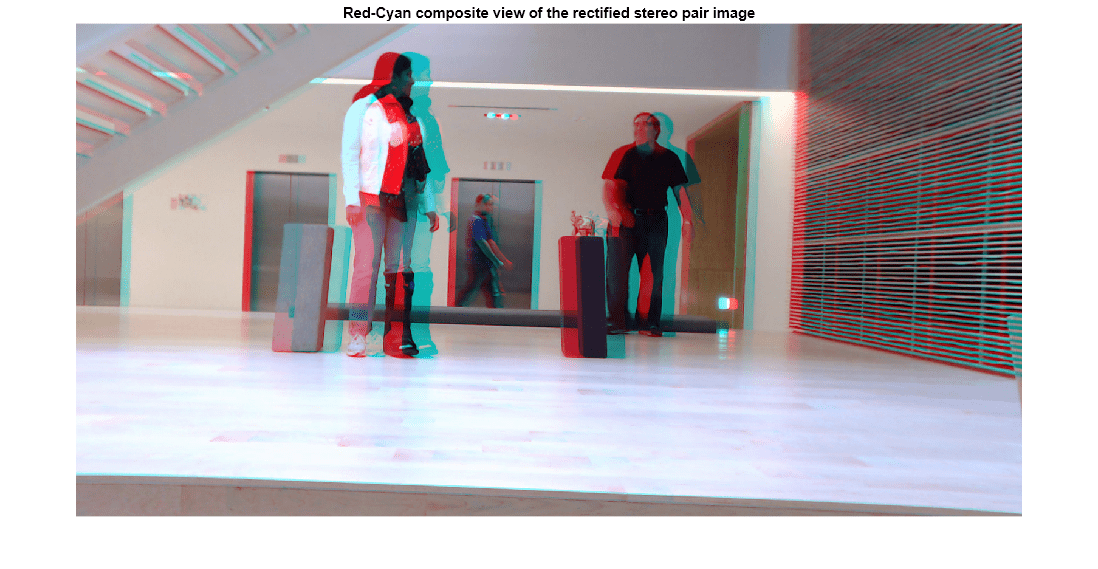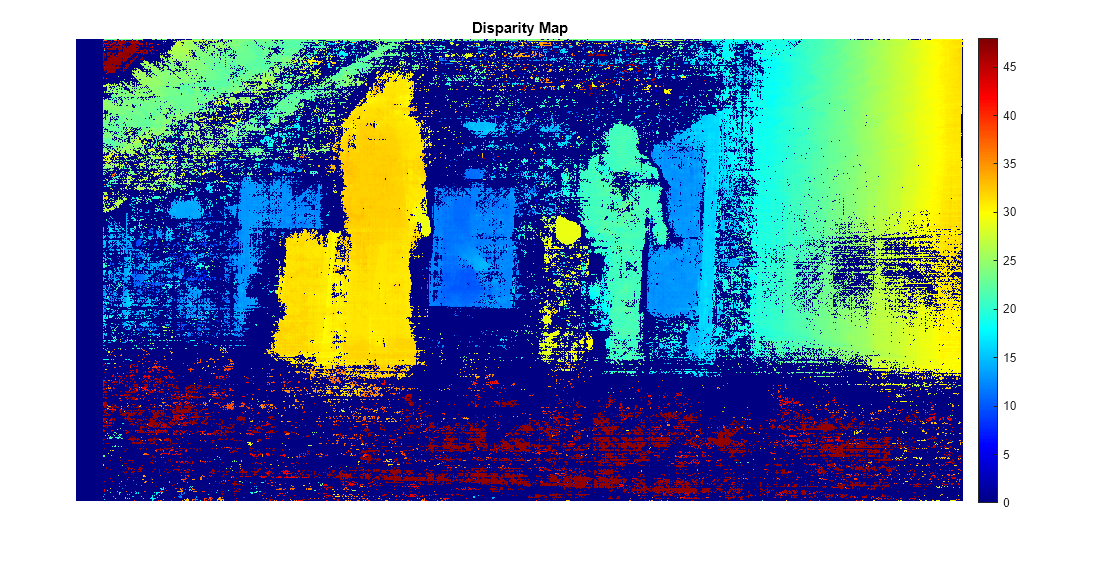disparitySGM
Compute disparity map through semi-global matching
Description
disparityMap = disparitySGM(I1,I2)I1 and
I2, by using semi-global matching (SGM) method. To know more about
rectifying stereo images, see Image Rectification.
disparityMap = disparitySGM(I1,I2,Name,Value)
Examples
Load a rectified stereo pair image.
I1 = imread("rectified_left.png"); I2 = imread("rectified_right.png");
Create the stereo anaglyph of the rectified stereo pair image and display it. You can view the image in 3-D by using red-cyan stereo glasses.
A = stereoAnaglyph(I1,I2);
figure
imshow(A)
title("Red-Cyan composite view of the rectified stereo pair image")
Convert the rectified input color images to grayscale images.
J1 = im2gray(I1); J2 = im2gray(I2);
Compute the disparity map through semi-global matching. Specify the range of disparity as [0, 48], and the minimum value of uniqueness as 20.
disparityRange = [0 48]; disparityMap = disparitySGM(J1,J2,"DisparityRange",disparityRange,"UniquenessThreshold",20);
Display the disparity map. Set the display range to the same value as the disparity range.
figure imshow(disparityMap,disparityRange) title("Disparity Map") colormap jet colorbar

Input Arguments
Input image referenced as I1 corresponding to camera 1,
specified as a 2-D grayscale image or a gpuArray (Parallel Computing Toolbox) object. The function uses this image as the reference image for
computing the disparity map. The input images I1 and
I2 must be real, finite, and nonsparse. Also,
I1 and I2 must be of the same size and same
data type.
Data Types: single | double | int16 | uint8 | uint16
Input image referenced as I2 corresponding to camera 2,
specified as a 2-D grayscale image or a gpuArray (Parallel Computing Toolbox) object. The input images I1 and
I2 must be real, finite, and nonsparse. I1
and I2 must be of the same size and same data type.
Data Types: single | double | int16 | uint8 | uint16
Name-Value Arguments
Specify optional pairs of arguments as
Name1=Value1,...,NameN=ValueN, where Name is
the argument name and Value is the corresponding value.
Name-value arguments must appear after other arguments, but the order of the
pairs does not matter.
Before R2021a, use commas to separate each name and value, and enclose
Name in quotes.
Example: disparitySGM(I1,I2,'DisparityRange',[0 64])
Range of disparity, specified as the comma-separated pair consisting of
'DisparityRange' and a two-element vector of the form
[MinDisparity
MaxDisparity]. MinDisparity is the minimum
disparity and MaxDisparity is the maximum disparity.
For input images of width N, the MinDisparity and MaxDisparity must be integers in the range (–N, N). The difference between the MaxDisparity and MinDisparity values must be divisible by 8 and must be less than or equal to 128.
The default value for the range of disparity is [0 128]. For
more information on choosing the range of disparity, see Choosing Range of Disparity.
Data Types: integers
Minimum value of uniqueness, specified as the comma-separated pair consisting of
'UniquenessThreshold' and a nonnegative integer.
The function marks the estimated disparity value K for a pixel as unreliable, if:
v < V×(1+0.01×UniquenessThreshold),
where V is the Hamming distance corresponding to the disparity value K. v is the smallest Hamming distance value over the whole disparity range, excluding K, K–1, and K+1.
Increasing the value of UniquenessThreshold
results in disparity values for more pixels being marked as unreliable. To disable the
use of uniqueness threshold, set this value to 0.
Output Arguments
Disparity map for rectified stereo pair image, returned as a 2-D grayscale image or
a gpuArray object. The function returns the disparity map with the
same size as input images I1 and I2. Each
value in this output refers to the displacement between conjugate pixels in the stereo
pair image. For details about computing the disparity map, see Computing Disparity Map Using Semi-Global Matching.
Data Types: single
More About
The input images I1 and I2
must be rectified before computing the disparity map. The rectification ensures that the
corresponding points in the stereo pair image are on the same rows. You can rectify the
input stereo pair image by using the rectifyStereoImages function. The reference image must be the same for
rectification and disparity map computation.
Algorithms
The range of disparity must be chosen to cover the minimum and the maximum amount of
horizontal shift between the corresponding pixels in the rectified stereo pair image. You
can determine the approximate horizontal shift values from the stereo anaglyph of the stereo
pair image. Compute the stereo anaglyph of the rectified images by using the stereoAnaglyph function. Display the stereo anaglyph in the Image
Viewer app. To measure the amount of horizontal shift between the corresponding
points in the stereo pair image, select Measure Distance
from the Tools menu in Image Viewer. Choose the
minimum and maximum disparity values for the range of disparity based on this measurement.
For example, this figure displays the stereo anaglyph of a rectified stereo pair image and the horizontal shift values measured between the corresponding points in the stereo pair image. The minimum and maximum shift values are computed as 12.3101 and 32.3757 respectively. Based on these values, the range of disparity can be chosen as [0, 48].

Compute Census transform of the rectified stereo pair image.
Compute Hamming distance between pixels in the census-transformed image to obtain the matching cost matrix.
Compute the pixel-wise disparity from matching cost matrix by using the semi-global matching method given in [1].
Optionally, mark the pixels for unreliability based on the
UniquenessThresholdname-value pair. The function sets the disparity values of the unreliable pixels toNaN.
References
[1] Hirschmuller, H. "Accurate and Efficient Stereo Processing by Semi-Global Matching and Mutual Information." In Proceedings of the IEEE Conference on Computer Vision and Pattern Recognition (CVPR), pp. 807-814. San Diego, CA: IEEE, 2005.
Extended Capabilities
The name-value pair arguments,
'DisparityRange'and'UniquenessThreshold'must be compile-time constants.Supports code generation only in generic
MATLAB Host Computertarget platform.
Usage notes and limitations:
The input images
I1andI2must be rectified, same size, and of same data type.GPU code generation supports the
'UniquenessThreshold'and'disparityMap'name-value pairs.For very large inputs, the memory requirements of the algorithm may exceed the GPU device limits. In such cases, consider reducing the input size to proceed with code generation.
The disparitySGM function
fully supports GPU arrays. To run the function on a GPU, specify the input data as a gpuArray (Parallel Computing Toolbox). For more information, see Run MATLAB Functions on a GPU (Parallel Computing Toolbox).
Version History
Introduced in R2019a
See Also
Apps
Functions
MATLAB Command
You clicked a link that corresponds to this MATLAB command:
Run the command by entering it in the MATLAB Command Window. Web browsers do not support MATLAB commands.
选择网站
选择网站以获取翻译的可用内容,以及查看当地活动和优惠。根据您的位置,我们建议您选择:。
您也可以从以下列表中选择网站:
如何获得最佳网站性能
选择中国网站(中文或英文)以获得最佳网站性能。其他 MathWorks 国家/地区网站并未针对您所在位置的访问进行优化。
美洲
- América Latina (Español)
- Canada (English)
- United States (English)
欧洲
- Belgium (English)
- Denmark (English)
- Deutschland (Deutsch)
- España (Español)
- Finland (English)
- France (Français)
- Ireland (English)
- Italia (Italiano)
- Luxembourg (English)
- Netherlands (English)
- Norway (English)
- Österreich (Deutsch)
- Portugal (English)
- Sweden (English)
- Switzerland
- United Kingdom (English)